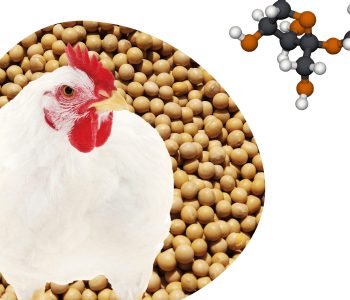Introduction
The main aim of this article is to explore a category of carbohydrates referred to as oligosaccharides, particularly emphasizing their presence in soybean meal when considering dietary considerations for broiler chickens.
The main oligosaccharides present in soybean meal are raffinose and stachyose. Both are formed by short chains of galactose, glucose, and fructose that bond together. Overall, these compounds beneficially influence the intestinal microbiota, although they can cause negative effects as they are considered anti-quality factors.
Therefore, it is worth mentioning that when discussing the formulation of diets for monogastric animals, it is essential to mention the two main ingredients used: corn and soybean meal.
As per the National Supply Company (Conab, 2023), in the 2022/23 harvest, the production reached around 155 million tons, with notable soybean-producing states being Mato Grosso, Paraná, Goiás, and Rio Grande do Sul (Table 1).
Table 1. Production indices of soybean grains in the main states of Brazil.
Adapted from Conab (2023).
| In terms of chemical composition, soybean meal contains approximately 45% crude protein, 4.86% crude fiber, 1.95% ether extract, 6% ash, and 17% other compounds. |
Table 2. Nutritional composition and protein quality of soybean meal from different geographical origins.
1 FDN – Neutral detergent fiber 2 KOH – Protein solubility in KOH 3 TIA – Trypsin inhibitor activity 4 AU – Urease activity
Oligosaccharides
[register]By definition, oligosaccharides are carbohydrates that consist of 2 to 10 monosaccharide units, which can be linear or branched and connected by α and/or β-glycosidic bonds (Patel et al., 2014). They serve as nutrients for beneficial microorganisms in the gastrointestinal tract, such as bacteria of the genera Bifidumbacterium and Lactobacilus (Patel and Goyal, 2011).
| Oligosaccharides are derived from plant sources like legumes and whole grains (Mussatto and Mancilha, 2007), using either physical-chemical methods or enzymatic hydrolysis of non-starch polysaccharides (NSP) (Courtois 2009; Zhao et al., 2017; Morgan et al., 2019). |
Table 3. Impact of dietary supplementation with oligosaccharides derived from non-starch polysaccharides on the composition of cecal microbiota in avian species.
Adapted from Jahan et al. (2022).
Raffinose
Raffinose is produced through the sequential addition of glycosyl groups to a sucrose marker within soybeans as they undergo ripening (Amuti & Pollard, 1977).
- Raffinoses fulfill significant physiological functions, including enhancing resistance to drought and low temperatures, facilitating respiration during germination, and prolonging the shelf life of legumes (Gu et al., 2018).
Although raffinose is considered an anti-quality factor for production animals, recent studies have shown that this compound can be used as a functional substance with prebiotic activity (Amorim et al., 2020).
The fact that raffinose is not digested in the upper gastrointestinal tract has sparked scientific interest in this compound.
Previous research has shown that raffinose promotes the proliferation of proteolytic bacteria, does not negatively impact the immune system, enhances the concentration of short-chain fatty acids in the cecum, and when administered in ovo, enhances the zootechnical performance metrics of broiler chickens (Bednarczk et al., 2011).
Supplementing broiler diets with raffinose holds promise, although few studies have been conducted to investigate its impact on performance.
Stachyose is an alpha-galacto-oligosaccharide consisting of two units of:
- α-galactose,
- one α-glucose
- one β-fructose
(Muland Perry, 1994).
Like raffinose, stachyose is also considered an anti-quality factor resistant to thermal processing, and in the case of soybean meal, it can represent 5 to 6% (Sorensen et al., 2011).
In a study conducted by Zhu et al. (2021), the use of 0.6% stachyose in the diet of broiler chickens was able to promote beneficial effects on cecal fermentation parameters, an improvement in microbiota profile was observed, and there was also a reduction in the formation of compounds that cause cecal odor, indole, and skatole.
According to Teague et al. (2023), the use of both raffinose and stachyose in broiler chicken diets can influence not only the performance of the animals but also intestinal integrity and quality, as well as microbiota composition.
Regarding alpha, which represents the number and abundance of bacterial species within a community, and beta diversity, which relates to the composition of species and their abundances between communities, the study by Teague et al. (2023) shows that increasing levels of raffinose and stachyose influenced the alpha and beta diversity of the microbiota (Figure 1), with emphasis on the abundance of bacteria from the Ruminococcus and Bifidobacterium genera represented in the graph by the light blue and dark yellow fractions (Figure 2).
Figure 1. Increasing levels of supplementation with raffinose and stachyose (GOS) and their effect on the composition of cecal microbiota. Adapted from Teague et al. (2023).
Adapted from Teague et al. (2023).
Figure 2. Alpha diversity represented by the Shannon index of the intestinal microbiota community of broiler chickens fed with increasing levels of raffinose and stachyose.
Adapted from Teague et al. (2023).
References available upon request [/register]
